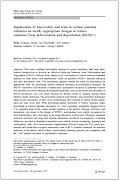| Journal Article |
 |
|
| Article Title | Implications of uncertainty and scale in carbon emission estimates on locally appropriate designs to reduce emissions from deforestation and degradation (REDD+) | | Author | Betha Lusiana, Meine van Noordwijk, Feri Johana, Gamma Galudra, S. Suyanto and Georg Cadisch | | Year | 2013 | | Journal Title | Mitigation and Adaptation Strategies for Global Change | | Institution | Springer | | Pages | 1-16 | | Call Number | JA0501-13 | | Keywords | Effective REDD+ design, Fairness and efficiency, Low-emission development, Scale dependence, Uncertainty of carbon emission |
|
| Abstract: |
| This study combined uncertainty analysis of carbon emissions with local stakeholders'
perspectives to develop an effective Reducing Emission from Deforestation and
Degradation (REDD+) scheme at the district level. Uncertainty of carbon emission estimates
depends on scale while local stakeholders' views on plausible REDD+ schemes influence
and limit transaction costs. The uncertainty analysis formed the basis for determining an
appropriate scale for monitoring carbon emission estimates as performance measures for
REDD+ incentives. Our analysis of stakeholder’ perspectives explored (i) potential location
and activities for lower emission development pathways, and (ii) perceived fair allocation of
REDD+incentives. Our case study focused on frontier forest in Tanjung Jabung Barat
District, Jambi, Indonesia. The uncertainty analysis used Monte Carlo simulation techniques
using known inaccuracy of land cover classification and variation in carbon stocks assessment
per land cover type. With decreasing spatial resolution of carbon emission maps,
uncertainty in carbon estimates decreased. At 1 km2 resolution uncertainty dropped below
5 %, retaining most of the coarser spatial variation in the district. Fairness, efficiency and
transaction cost issues in the design of REDD+ mechanisms were readily recognized by
local stakeholders, who converged on an equal allocation to short-term efficiency (emission
reduction activities) and long-term fairness (alternative livelihood development). A striking
difference occurred in desirable transaction costs (which include monitoring, reporting and
verification), with Non-Governmental Organizations (NGOs) aiming for 8 %, while government
and researchers accepted transaction costs of 40 %. Feasible measures for emission
reduction in the district, derived from a participatory planning process, are compatible with
the 1 km2 spatial resolution of performance measures. |
|
|
Download file(s): Click icon to download/open file.
|
| |
File Size |
Description |

|
538 KB |
Softcopy |
|
|
|
| Viewed in 1399 times. Downloaded in 162 times. |